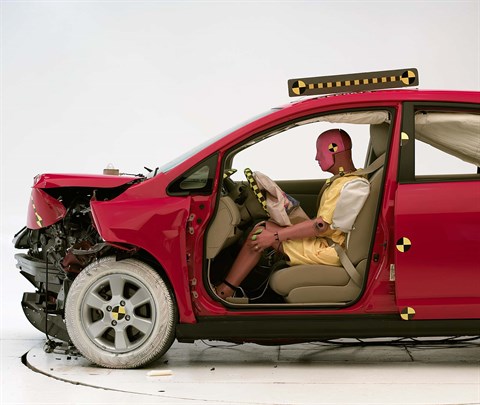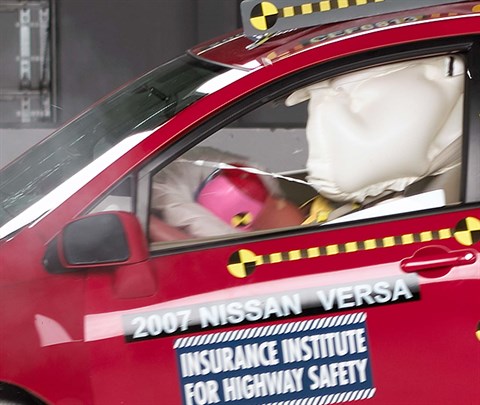Moderate overlap front: original test
Rating applies to 2007-12 models
Tested vehicle: 2007 Nissan Versa 1.8 SL 4-door hatchback
The Nissan Versa was introduced in the 2007 model year. The frontal offset crash test ratings apply to both the hatchback and sedan versions of the car through the 2011 model year. Beginning with 2012 models, the sedan was redesigned but the hatchback was not. Therefore the frontal offset ratings detailed below do not apply to the 2012 model sedan.
| Evaluation criteria | Rating |
|---|---|
| Overall evaluation | |
| Structure and safety cage | |
| Driver injury measures | |
| Head/neck | |
| Chest | |
| Leg/foot, left | |
| Leg/foot, right | |
| Driver restraints and dummy kinematics | |

Action shot taken during the frontal offset crash test.

The dummy's position in relation to the steering wheel and instrument panel after the crash test indicates that the driver's survival space was maintained well.

A high head acceleration occurred when the dummy's head hit the steering wheel through the airbag.

Intrusion into the driver's space was minimal, and all leg and foot injury measures were low.
Measures of occupant compartment intrusion on driver side
| Evaluation criteria | Measurement |
|---|---|
| Test ID | CEF0613 |
| Footwell intrusion | |
| Footrest (cm) | 7 |
| Left (cm) | 10 |
| Center (cm) | 10 |
| Right (cm) | 12 |
| Brake pedal (cm) | 12 |
| Instrument panel rearward movement | |
| Left (cm) | 1 |
| Right (cm) | 3 |
| Steering column movement | |
| Upward (cm) | 1 |
| Rearward (cm) | -3 |
| A-pillar rearward movement (cm) | 0 |
Driver injury measures
| Evaluation criteria | Measurement |
|---|---|
| Test ID | CEF0613 |
| Head | |
| HIC-15 | 492 |
| Peak gs at hard contact | 97 |
| Neck | |
| Tension (kN) | 1.3 |
| Extension bending moment (Nm) | 17 |
| Maximum Nij | 0.37 |
| Chest maximum compression (mm) | 29 |
| Legs | |
| Femur force - left (kN) | 0.4 |
| Femur force - right (kN) | 3.0 |
| Knee displacement - left (mm) | 3 |
| Knee displacement - right (mm) | 1 |
| Maximum tibia index - left | 0.30 |
| Maximum tibia index - right | 0.33 |
| Tibia axial force - left (kN) | 1.8 |
| Tibia axial force - right (kN) | 1.3 |
| Foot acceleration (g) | |
| Left | 70 |
| Right | 54 |
Side: original test
Rating applies to 2011-12 models
Tested vehicle: 2011 Nissan Versa SL 4-door hatchback with standard front and rear head curtain airbags and standard front seat-mounted torso airbags
The Nissan Versa was introduced in the 2007 model year. Beginning with 2011 models, Nissan made design changes to the side curtain airbags. Side ratings are assigned by the Institute based on a test conducted by Nissan. However, because there were no significant side structural changes, the structure rating of the current model is based on both Nissan's test and an earlier Institute test of a 2007 model.
Note: The side ratings detailed below apply to both the hatchback and sedan versions of the car in the 2011 model year. Beginning with 2012 models, the sedan was redesigned but the hatchback was not. Therefore these ratings do not apply to the 2012 model sedan.
| Evaluation criteria | Rating |
|---|---|
| Overall evaluation | |
| Structure and safety cage | |
| Driver injury measures | |
| Head/neck | |
| Torso | |
| Pelvis/leg | |
| Driver head protection | |
| Rear passenger injury measures | |
| Head/neck | |
| Torso | |
| Pelvis/leg | |
| Rear passenger head protection | |
Measures of occupant compartment intrusion on driver side
| Test ID | CES0642 | VTS1014 |
|---|---|---|
| B-pillar to longitudinal centerline of driver's seat (cm) | -6.5 | -6.5 |
| Negative numbers indicate the amount by which the crush stopped short of the seat centerline. | ||
Driver injury measures
| Evaluation criteria | Measurement |
|---|---|
| Test ID | VTS1014 |
| Head HIC-15 | 508 |
| Neck | |
| Tension (kN) | 1.0 |
| Compression (kN) | 0.1 |
| Shoulder | |
| Lateral deflection (mm) | 50 |
| Lateral force (kN) | 1.8 |
| Torso | |
| Maximum deflection (mm) | 54 |
| Average deflection (mm) | 46 |
| Maximum deflection rate (m/s) | 5.90 |
| Maximum viscous criterion (m/s) | 1.31 |
| Pelvis | |
| Iliac force (kN) | 3.7 |
| Acetabulum force (kN) | 2.9 |
| Combined force (kN) | 6.4 |
| Left femur | |
| L-M force (kN) | 0.3 |
| L-M moment (Nm) | 73 |
| A-P moment (Nm) | 105 |
Passenger injury measures
| Evaluation criteria | Measurement |
|---|---|
| Test ID | VTS1014 |
| Head HIC-15 | 308 |
| Neck | |
| Tension (kN) | 0.7 |
| Compression (kN) | 0.2 |
| Shoulder | |
| Lateral deflection (mm) | 34 |
| Lateral force (kN) | 1.5 |
| Torso | |
| Maximum deflection (mm) | 33 |
| Average deflection (mm) | 30 |
| Maximum deflection rate (m/s) | 4.00 |
| Maximum viscous criterion (m/s) | 0.42 |
| Pelvis | |
| Iliac force (kN) | 0.7 |
| Acetabulum force (kN) | 1.8 |
| Combined force (kN) | 2.2 |
| Left femur | |
| L-M force (kN) | 0.5 |
| L-M moment (Nm) | 39 |
| A-P moment (Nm) | 92 |
Roof strength
Rating applies to 2007-12 models
Tested vehicle: 2011 Nissan Versa 1.6 4-door
Rating applies to both the Nissan Versa sedan (tested) for model years 2007-11 and the structurally similar Nissan Versa hatchback (5-door) for model years 2007-12.
| Overall evaluation | |
|---|---|
| Curb weight | 2,552 lbs |
| Peak force | 9,414 lbs |
| Strength-to-weight ratio | 3.69 |
Head restraints & seats
Seat type: Manual cloth seats AHR
| Overall evaluation | |
|---|---|
| Dynamic rating | |
| Seat/head restraint geometry |
| Seat type | Manual cloth seats AHR |
|---|---|
| Geometry | |
| Backset (mm) | 60 |
| Distance below top of head (mm) | 60 |
| Seat design parameters | |
| Pass/fail | Pass |
| Max T1 acceleration (g) | 13.2 |
| Head contact time (ms) | 65 |
| Force rating | 1 |
| Neck forces | |
| Max neck shear force (N) | 77 |
| Max neck tension (N) | 543 |
About the head restraint & seat test
Currently, IIHS tests apply only to front seats.
